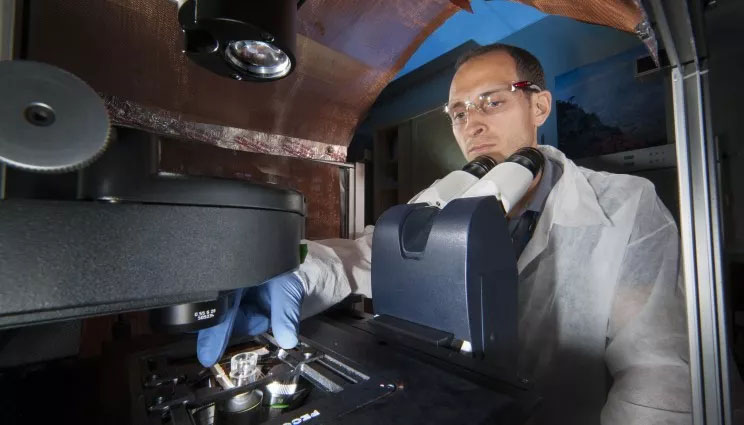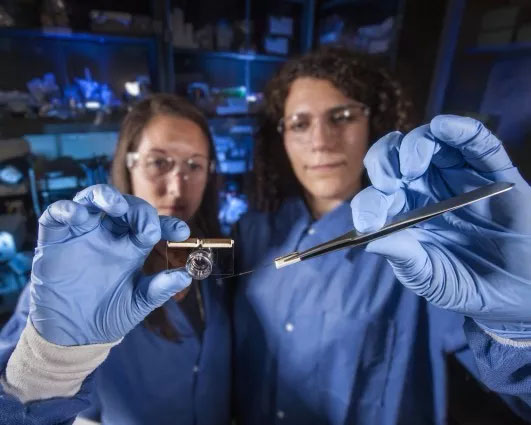Brain on the chip
Release date: 2018-01-11

Dave Soscia, a research engineer at Lawrence Livermore National Laboratory (LLNL), is examining the "brain chip" device under a microscope. The device is part of LLNL's iCHIP (in-vitro Chip-Based Human Investigational Platform) project, which simulates the central nervous system by recording the neural activity of various brain cell types deposited and grown onto microelectrode arrays. Image source: LLNL
Scientists and engineers at Lawrence Livermore National Laboratory have developed a "brain chip" device designed to test and predict the effects of chemical and biological agents, diseases or drugs on the brain.
This device is part of the laboratory iCHIP project to simulate the central nervous system by recording the neural activity of various brain cell types deposited and grown onto the microelectrode array. The study, published in the January issue of PLOS One, helps scientists understand how brain cells connect and interact with each other, fight against brain barriers, determine how soldiers are affected by chemical and biological weapons, and develop antidote to counteract these influences.
"Although we are still far from fully recognizing the brain outside the body, this is an important step in improving equipment complexity and moving in the right direction," said research co-author Dave Soscia, a research engineer at LLNL. “We will gradually be confident that the effects of the chemicals and drugs observed in such devices in the platform environment will be similar to those observed in humans.â€
To reconstruct the structure of the brain, the researchers divided the chip into four distinct regions, three subregions and an outer region representing the cerebral cortex. The researchers cultured primary hippocampal and cortical cells on electrodes, based on their relative position in the brain, using custom inserts, which can then be removed after the cells are placed in the device to allow Free communication of cells between different regions. The team monitored the cell's underlying mode of action—the discharge during intercellular synaptic communication—and observed how cells interacted over time. The researchers also successfully completed four cell insertion tests to demonstrate that multiple cell types can be used simultaneously.
Scientists say the platform allows them to study the composition of the network between different regions of the brain and to acquire human-related data in a timely manner without the involvement of animals or humans in experiments. Data can be used to better predict human response to countermeasures, viruses, or drugs, and can help scientists determine whether a particular type of nerve cell is susceptible to exposure.
“This allows us to use the platform to test how the chemical affects the brain,†said iCHIP principal investigator Elizabeth Wheeler. “Obviously, we know that at high doses, exposure is harmful, but think about it. Warriors will be exposed to low levels of chemical conditions for a long time. In the future, using this device we may be able to predict under what circumstances the brain is affected. If we understand how it happens, then we can Develop appropriate countermeasures to protect them."

LLNL researchers Heather Enright (left) and AnnaBelle (right) show brain chip devices and microelectrode arrays. Image source: LLNL
The researchers also said that the technology also allows them to observe how different types of cells communicate with each other when they are in close proximity. Cell deposition is performed by microfabricated, funnel-like inserts that allow the insert to be applied to any type of cell and chip platform, as this eliminates the need to specialize the surface of the chip with various chemicals to Cells can be adsorbed on it. The system, Soscia says, allows researchers to easily move from "macro world to the world," and that this method can deposit more cell types in smaller areas than in the past.
“It's very important for us, we don't have physical barriers, so cells can programmatically grow and interact and communicate,†Soscia said. “Here, you insert a patch and then drive the cells through the top of the insert. The cells are precisely deposited in specific areas of the electrode array. Then, as it is removed, the cells adhere but lose support, allowing them to grow freely and communicate with other areas."
For this proof-of-concept study, the scientists analyzed the electrical activity of rodent cells for up to 30 days, and the cells showed the characteristics and changes of the simulated physiological responses described in the literature. Based on experiments, they predict that brain cells can remain functional on the chip for a longer period of time, for months. The researchers compared the differences between hippocampus and cortical neurons in single and co-culture. Studies have shown that certain characteristics of hippocampal somatic cells, such as the percentage of peak action potentials found during an outbreak, are significantly elevated when cultured with cortical cells.
LLNL biologist Kris Kulp said: "We found that even though cortical neurons exist, hippocampal neurons still look like hippocampal neurons, but they do change some of their characteristics according to different 'neighbors'. They retain Identification features, but their communication methods are slightly different."
Kulp said researchers can use brain-chip platforms to analyze how diseases spread in the brain, models of epilepsy, or the potential to detect chemical or biological exposures over a period of several months.
“You can simulate that some people have a short exposure to the harmful environment on the battlefield, and then monitor the neurons for the next six months to see what happens,†Kulp said. “Maybe they The initial contact recovered, but after six months, they still have some damage. This is the only system that allows this kind of experiment on human cells."
The study continues, and as part of a brain-focused strategic plan, LLNL biologist Nick Fischer is the lead researcher. The program combines the brain and blood brain barrier chip platforms for applied scientific research. The next step, the researchers say, is to extend the brain chip device to three dimensions and sort the data collected so far to determine its relevance to in vivo data.
The researchers said, "Since we have demonstrated the capabilities of the device and mimicked certain features of the brain, we need to work more closely with computer scientists, statisticians, and data modelers to analyze the data. From an idea to It’s exciting to use a platform to generate data and now use it to inform predictive biological models."
Reference material
[1] 'Brain-on-a-chip' tests effects of biological and chemical agents, develop countermeasures
Source: Health New Vision (Micro Signal HealthHorizon)
Digital Safe ,Digital Safe Box,Large Digital Safe,Safe Box For Home
Ningbo Zhaomu Electronic Commerce Co., Ltd. , https://www.bofonhome.com